Nearly 100 years ago, a man tried to blast off to Venus. Now a documentary crew is on a mission to find the rocket built for that journey.
The day Robert Condit set fire to a hunk of metal filled with 50 gallons of gasoline, it was supposed to be only a test. The hope was that the bullet-nosed contraption that he’d designed and built with the help of two brothers, Harry and Sterling Uhler, would find the propulsion necessary to leave the pockmarked macadam of a city street. It was 1927, a warm August afternoon. The kind of blue-sky day that inspires trouble in bored kids, but these were three grown men, in their 30s, standing on a street in Hampden, a neighborhood just north of downtown Baltimore.
The 24-foot-tall rocket, an amalgamation of angle iron, scrap materials and amateur engineering was meant to eventually blast Condit out of Earth’s atmosphere and to the planet Venus. Charles Lindbergh had managed the width of the Atlantic Ocean in a monoplane earlier that year, and flying great distances was no longer a daydream. Why not aim for the stars?
“If a man like Lindbergh had the courage to lead the way at the risk of his life, we thought, other men should have the courage to follow,” Harry Uhler wrote in a 1969 article for the Baltimore Sun Magazine about their venture. The Uhler brothers had invested their money and eight months of their spare time welding and tinkering inside a two-car garage on Morling Avenue, following plans for a piloted craft that Condit had conceived. Harry and Sterling both worked with their hands for a living. They referred to Condit, who had attended high school at Baltimore Polytechnic Institute, as the mathematical wizard. Condit, for his part, afforded himself a wide range of professional titles, claiming to be an engineer, a chemist, a professor and the all-encompassing inventor. Now they were ready to see if what they’d labored to create would catch air. Condit speculated to the Uhlers that the fuel might propel him a quarter of a mile up that day. He had a silk parachute stashed inside the nose to land. If all went well, Condit would later aim for Venus.
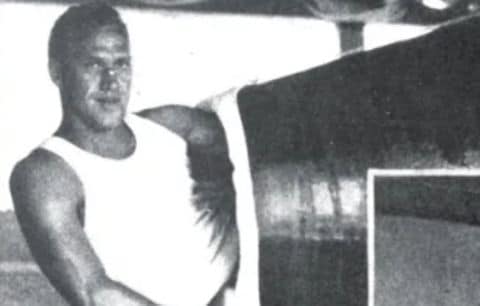 A publicity photo from 1928 shows inventor Robert Condit and his rocket. (Courtesy of Urban Goat Films)
A publicity photo from 1928 shows inventor Robert Condit and his rocket. (Courtesy of Urban Goat Films) Word had leaked that three men were testing a rocket off a sidewalk, and a crowd began to gather, among them the Uhlers’ nonplussed wives. Condit unscrewed the metal nose and climbed inside. He flipped a switch to begin his journey.
“I never saw so much fire in my life,” Harry Uhler wrote. “Big blooms of red flame boiled out around the spacecraft, and big clouds of black smoke rolled up into the sky.” The rocket “leapt up off the sidewalk,” less than 100 feet in the air, according to Harry, and then it crashed into a nearby building, supposedly breaking Condit’s legs. Later, the trio estimated it would take at least another $10,000 to get the rocket flight-ready, so Harry and Sterling reluctantly walked away. “Our wives were against the whole deal, anyway,” Harry wrote.
Condit, who was described in the press at the time as a beguiling faddist with a penchant for gregarious chatter, left Baltimore shortly after, taking his rocket with him. The legend of the launch flashed and burned bright through Hampden, then dissipated over the years, and just like Robert Condit and his rocket, disappeared.
Now, three longtime friends living in Baltimore — John Benam, Brian Carey and Geoff Danek — along with a film crew, are trying to fill out the story of Robert Condit and his rocket for a documentary titled “Rocket to Venus.” In January, they retraced Condit’s movements to Miami Beach, where they learned he had taken the rocket after leaving Baltimore. Condit had made international news when he announced that he would launch himself into space from the Florida beach, including a December 1927 mention in The Washington Post under the headline “A Jaunt to Venus.”
“Time and again some hardy soul hoped to reach the stars,” the article read. “Never, so far as is known, has the feat been attempted: but no one had possessed a machine such as Mr. Condit has developed.”
Condit’s “science was surely lacking, but not his bravado,” Frank H. Winter wrote in his 1983 book “Prelude to the Space Age: The Rocket Societies: 1924-1940.” Winter, a retired curator of rocketry at the Smithsonian National Air and Space Museum, tells me that the rocket as described by Uhler was so misguided as to be laughable. By the spring of 1928, Condit had “not yet succeeded in divorcing himself from Mother Earth,” according to another news report of the time, and he called off the Miami Beach launch because of bad weather. He disappeared once more, this time for good.
“In the course of the next few years, we will probably be doing business with Venus as casually as we now transact our affairs across the ocean,” Robert Condit wrote in a 1928 lecture.
The filmmakers have uncovered a trove of documents nearly a century old that not only suggest Condit’s rocket may still be out there somewhere, but that Condit was more tapped in to the zeitgeist of his time than previously known. His rocket, while outlandish, represented a moment of pioneering aspiration in space travel. Condit was among a group of would-be rocketeers who, in the era before the space race, were applying new technologies to ideas for space travel. With memories of the First World War and the lingering fears of the influenza pandemic still fresh, these men and women looked to the cosmos and channeled the pain of daily life into the promise of discovery in space.
“It will not be very long until we know just what we have for neighbors,” Condit wrote about space travel in a 1928 lecture discovered by the filmmakers, “and in the course of the next few years, we will probably be doing business with Venus as casually as we now transact our affairs across the ocean or go for an aeroplane ride of a few thousand miles before breakfast.”
Our obsession with, and commitment to, space travel has waxed and waned over the past 100 years or so, as the gravity of life on Earth has pulled our attention in various directions. But today, space seems to be calling to us again after a long silence, and our desire to explore the cosmos is being stoked by a new generation of determined rocketeers. In May, Elon Musk’s company SpaceX launched astronauts from American soil for the first time in nearly a decade, ferrying them to the International Space Station on its Falcon 9 rocket. Musk, along with NASA, now have their sights set on Mars, and the once far-fetched idea of putting humans on the Red Planet seems like a possibility. Condit may have lacked the chops to get to space, but for a moment in time, he had people looking up and believing humans might soon witness an alien world. Condit, the documents show, helped spark global excitement at the possibility of space travel, and in the unfolding story of one of America’s earliest dreamers, we can see reflected the ambitions of today’s pioneering rocketeers, stirring our desire to once again send humans to other planets.
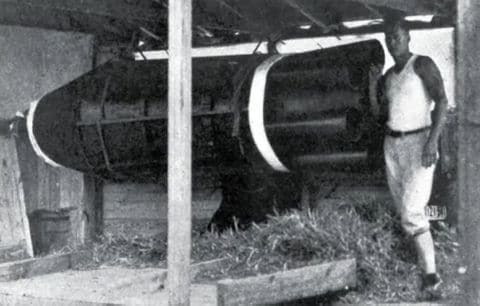 Condit’s rocket was made of angle iron and scrap materials. (Courtesy of Urban Goat Films)
Condit’s rocket was made of angle iron and scrap materials. (Courtesy of Urban Goat Films) The story of how a piloted rocket came to exist more than 40 years before we set foot on the moon is as much about the place where it was created as it is about the early aspirations of space enthusiasts. Morling Avenue in Hampden twists along the edge of a steep hill, a cluster of classic Baltimore rowhouses clinging to its side. In 1927, Harry Uhler lived in the 1400 block. Behind the house, a valley unfurls to the shores of the Jones Falls, a river that rushes from its source in rural Maryland, creating rapids at a geological fall line here, before continuing its path to the Chesapeake Bay. Starting in the 1800s, mills built of quarried stone popped up along the shore to take advantage of the hydropower, attracting workers from rural Appalachia wanting a new life in the industrializing North. Inside the mills they made cotton duck for the sails that went on speedy clipper ships used in global trade. They made the iron that became part of the skeleton of the U.S. Capitol Building. Less than five miles from downtown Baltimore and bordered at its eastern edge by Johns Hopkins University, Hampden is still an enclave that looks more like Appalachia in places than a part of the city.
Back then, Harry earned $50 a week working as a stonemason in and around the mills, and his younger brother Sterling earned $1.25 an hour as a carpenter. Across the street from Harry, their neighbor Ed Weise owned a house with a garage dug into the side of the hill next to it, like a war bunker. Two large wooden doors opened to the street, and the garage’s pitched roof was high enough to contain something tall. Weise was Condit’s uncle, according to the filmmakers, and Condit borrowed the garage to work on his rocket. It’s unclear how he first met the Uhler brothers, but it’s not hard to imagine the brothers sitting on the porch across the street and seeing Condit working on his curious machine.
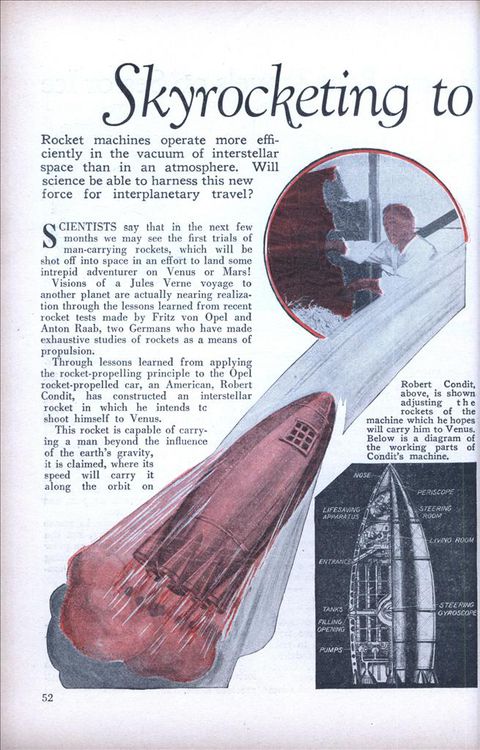 An article about Condit’s rocket in Modern Mechanics and Inventions magazine from November 1928. (Modern Mechanics and Inventions)
An article about Condit’s rocket in Modern Mechanics and Inventions magazine from November 1928. (Modern Mechanics and Inventions) Condit dreamed the rocket, and the Uhler brothers helped build it. They used angle iron ribs, perhaps supplied by the same mill that contributed to the Capitol. They wrapped the rocket in sailcloth from another mill and shellacked it in varnish to create a hard shell. An air compressor was installed to spray liquid fuel into eight steel pipes that they had outfitted with a spark plug and a battery to ignite the gas. There was room inside for one man, with access through the removable nose of the rocket. They lined the interior with 1½-inch pipes meant to supply water for the journey and to help insulate Condit from the black chill of space. There were two glass portholes to see out. Condit had everything he believed he needed: flashlight, first aid kit, and a bow and arrows, which would come in handy for “procuring small game for food,” he wrote in notes uncovered by the filmmakers. There was no radio to communicate with Earth. He would try to build one from parts of the rocket when he landed on Venus.
Neighbors thought they were nuts. Harry later recalled walking Hampden’s main street of shops and restaurants, known as the Avenue, and people making a Swoosh! sound and pointing to the sky. “See you on Venus!” they’d say and laugh. Still, people came from all over the neighborhood to get a glimpse of the rocket, according to Harry’s written account.
Today, the garage on Morling Avenue looks much as it did in 1927. When Geoff Danek bought Ed Weise’s former house in 2002, he had no idea of its history. The Hampden mills that were thriving when Condit was alive had died after World War II, and their hulking structures lay fallow for years until the artists and musicians came and carved performance and studio spaces out of the cavernous rooms — some legal, some not. People began creating inside the mills again, producing music and sculpture, furniture and films. The scrappy weirdness of Hampden inspired a young filmmaker named John Waters to set several of his movies here.
The bootstrap creativity of the area lured childhood friends Brian Carey and Geoff Danek from the suburbs of Maryland. By the mid-1990s, Carey was often touring with his band, while Danek and a partner bought a sliver of a building on the Avenue in Hampden. Many of the storefronts on the main drag were still suffering from postindustrial vacancies, and the old-timers from the neighborhood were curious about what this young kid was up to. They would walk by as Danek worked on the place and pause. “What are you building in there?”
“A Mexican restaurant,” Danek would tell them.
“Good luck with that,” they’d say and laugh.
It was at the bar of his restaurant, Holy Frijoles, that a friend popped in for a drink one night and asked Danek about his house on Morling. “You know that three guys built a rocket to Venus in your garage, right?”
Danek had never heard the story. He soon spent hours at the library winding through microfiche and reading all that he could find on Condit from the 1920s. “I became a little obsessed,” he says, and he pulled his buddy Carey in to help. After the spate of news accounts from Miami Beach through 1928, though, their archival search hit a dead end. “There was a rumor online that Condit had stolen a mail truck and taken it across country to California,” Carey says. “But after Miami, it’s like Robert Condit fell off the face of the Earth.”
In 2006, Danek and Carey opened a restaurant in Hampden, and they called it Rocket to Venus in honor of the intrepid trio. Condit’s rocket served as inspiration for the interior, including a bar they built with a friend using hundreds of feet of half-inch copper tubing to emulate the interior water pipe system. All that time, “I kept wondering what made a guy build a rocket in the 1920s,” Carey says. “I mean, did he really think he could get there?”
 Geoff Danek in his garage in Baltimore’s Hampden neighborhood. Danek’s house once belonged to Condit’s uncle, and Condit worked on his rocket in this garage. In back is Brian Carey. (Daphne Glover Ferrier/Courtesy of Urban Goat Films)
Geoff Danek in his garage in Baltimore’s Hampden neighborhood. Danek’s house once belonged to Condit’s uncle, and Condit worked on his rocket in this garage. In back is Brian Carey. (Daphne Glover Ferrier/Courtesy of Urban Goat Films) The 1920s and ’30s were ripe years for the early evolution of space travel. Rockets, in the form of fireworks, had been around since at least 1200 in China, and the concept of a man riding a rocket into space was common fodder for science fiction writers like Jules Verne. These early rockets, both real and imagined, used solid fuel, like gunpowder, for their boost. Verne set his 1865 book “From the Earth to the Moon” in Baltimore, imagining a rifle club determined to build a cannon powerful enough to shoot a projectile into space. “Now when an American has an idea, he directly seeks a second American to share it,” Verne wrote. “If there be three, they elect a president and two secretaries.”
Verne joked, but by the early 1900s rocket societies were forming across America — and Europe — with the express intent of sending rockets to the stars. Telescopes had become powerful enough to peer deeper into the cosmos, and some believed that intelligent life existed on other planets. Italian astronomer Giovanni Schiaparelli had trained his eye on Mars in 1877 and saw what he described as channels on the surface. The Suez Canal, completed eight years earlier, was the engineering marvel of the era, and the world had seaways on its mind. The public took Schiaparelli’s report to mean that intelligent life had built canals there. American astronomer Percival Lowell, from his observatory in Arizona, concluded that the canals on Mars were quite real, and he wrote several books, starting in 1895, filled with his speculations about life on the planet.
 (Joseph Gough)
(Joseph Gough) At the turn of the 20th century, much of the science to get to space existed, but the technology and engineering did not. Members of the new societies were “the most optimistic yet naïve young men and women,” Winter wrote in “Prelude to the Space Age.” Nevertheless, “they made important contributions” to the future of space travel by toying with designs and, perhaps most of all, by disseminating the idea to the general public that science fiction could become reality. “Publicity, these early pioneers were to discover, was everything. Whether their methods were technically sound was immaterial,” Winter wrote.
By the 1920s, when Condit arrived on the scene, technology was starting to catch up. The burgeoning airline industry spurred advancements in lightweight alloy metals and aerodynamics; meanwhile an engineer named Robert H. Goddard was experimenting with the science that would eventually help land us on the moon.
Outside the pockets of true believers, though, skeptics roundly mocked the efforts of rocket enthusiasts. In 1919, Goddard published a treatise for the Smithsonian titled “A Method of Reaching Extreme Altitudes” in which he hypothesized shooting a rocket that could set off flash powder on the moon’s surface and be visible from Earth. When the treatise was picked up by the press, Goddard was dubbed the Moon Man. An editorial in the New York Times dismissed him as a loon who “seems to lack the knowledge ladled out daily in high schools.”
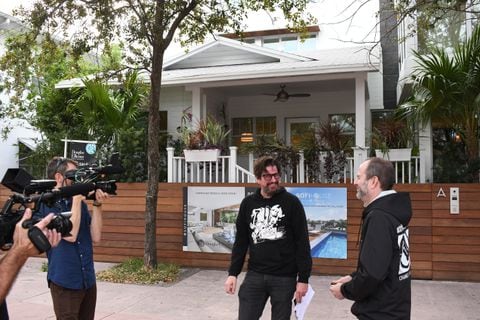 John Benam, left, films Danek and Carey outside Condit’s house in the South Beach neighborhood of Miami Beach, Fla., during their search for the rocket. (Daphne Glover Ferrier/Courtesy of Urban Goat Films)
John Benam, left, films Danek and Carey outside Condit’s house in the South Beach neighborhood of Miami Beach, Fla., during their search for the rocket. (Daphne Glover Ferrier/Courtesy of Urban Goat Films) Goddard kept his work secret from then on, including the day in March 1926, a year before Condit’s attempt, when he launched the world’s first liquid-propellant rocket. Instead of solid fuel like gunpowder, Goddard correctly surmised that liquid fuel was the way to get a rocket into space. His science was far savvier than Condit’s, yet Goddard’s early experiment was not unlike three guys setting fire to a rocket on a city sidewalk. Goddard released his from a hill on his Aunt Effie’s farm in Massachusetts, where it shot over nearby Auburn “like a celestial demon” according to one account, alarming neighbors who called the police.
Even more influential to rocket societies, particularly those in Europe, was a German professor named Hermann Oberth. Like Goddard, he believed liquid propellants were the way to go, but he went a step further: What would it mean to not just shoot a rocket into space, but to put a person up there along with it? His 1923 publication “Die Rakete zu den Planetenräumen” (“The Rocket Into Interplanetary Space”) posited a vision for a piloted rocket that considered not only the technology, but also the questions of food, space suits, a space station and other practical matters.
“One of the characteristic features of this time was the belief in the heroic cult of the inventor,” Michael J. Neufeld, a senior curator in the Space History Department at the National Air and Space Museum, tells me. “The great successes of Thomas Edison and Henry Ford and others led people to believe that a brilliant inventor could go out and create something whole cloth out of his mind. There was no understanding of the huge military-industrial complex that was actually needed for building a rocket for space travel. Back then, it was thought that the heroic inventor who is financed by some rich capitalist could do anything.”
“Everyone told me how smart he was,” Lance C. Barley says of his great-uncle. “And he was, well, you know, over the top.”
While researching his book about rocket societies, Winter concluded that Condit was naive at best. At worst, perhaps, a con man who took the gullible Uhler brothers for a steep sum. Winter called Sterling Uhler in the early 1980s. The two had a quick conversation, the gist of which, Winter says, is that Sterling seemed quite sincere about Condit’s intention of reaching Venus. “But there is a snake oil salesman element to this story,” Winter says today, “and the fact that Condit just disappeared kind of fits into that notion.”
For years, though, something has gnawed at him. He can’t square how Condit knew to fuel his rocket. “Goddard only released details of his liquid-propelled rocket experiment in 1936, a full decade after he conducted it,” Winter says, and a full nine years after Condit’s Baltimore attempt. Oberth was writing primarily in German. The knowledge of using a liquid propellant to fuel a rocket in 1927 “was almost unknown.” So how, he wonders, was Condit clever enough to use gas?
Condit, it turns out, understood something pivotal about rocketry, and the evidence of that knowledge had been stashed for decades inside a closet less than 11 miles from Hampden.
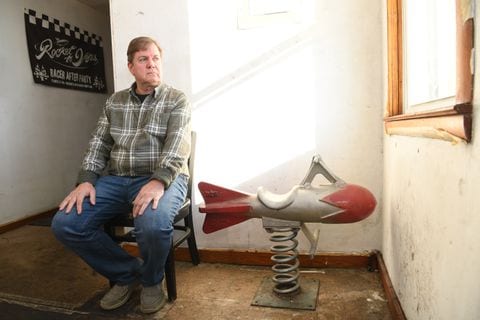 Lance C. Barley, Condit’s great-nephew, inherited a satchel of the inventor’s papers, which he loaned to the filmmakers. (Jim Burger/For The Washington Post)
Lance C. Barley, Condit’s great-nephew, inherited a satchel of the inventor’s papers, which he loaned to the filmmakers. (Jim Burger/For The Washington Post) A few years after the opening of Rocket to Venus restaurant, relatives of the Uhler brothers began showing up to meet the restaurateurs who had honored their progenitors. Danek and Carey sat with them for hours, hearing stories of the past. “We learned from Sue, Sterling Uhler’s daughter, that her dad was proud of what they’d done, but they were made fun of a lot,” Danek says. “Some of the family were embarrassed, and they wanted to keep the rocket a secret.”
The stories rekindled their long-simmering desire to learn what had happened to the rocket. In 2015, another childhood friend, John Benam, began capturing these family recollections on film. Benam is an Emmy Award-winning documentary filmmaker who has traveled the world with outlets such as National Geographic and PBS. Back then, he had just finished work on the critically acclaimed Netflix series “The Keepers,” about the unsolved killing of Baltimore nun Catherine Cesnik. He had been hearing the story of the rocket from his friends for years, and it “kept nagging at all of us,” Benam tells me. The Uhler family relatives didn’t know what became of it, though, or of Condit.
Condit, not understanding that Venus’s atmosphere would choke any living thing, speculated that the planet’s inhabitants might have multiple limbs — and that they were probably naked.
The three friends decided it was time to find out. Along with co-director Robert Ferrier, producer Daphne Glover Ferrier and cameraman-editor Todd Evans, they created Urban Goat Films (named for the goats Danek keeps in his yard on Morling Avenue), and their search for the rocket began in earnest. Robert Ferrier created a Facebook page to find relatives of the original rocketeers, and in late 2018, a man named Lance C. Barley reached out. He told Ferrier he had something he needed to show them.
On the Friday after Thanksgiving, Barley drove to Baltimore from his house in Anne Arundel County. He pulled onto Chestnut Avenue in Hampden and knew he was in the right place when he saw a vintage amusement park rocket jutting off the side of a rowhouse.
Barley is Robert Condit’s great-nephew, and in an interesting twist he works at the Johns Hopkins Applied Physics Lab overseeing the mechanical fabrication shop where they make, among other things, devices such as the Parker Solar Probe, intended for interplanetary research. Barley grew up hearing whispers of the relative who had wanted to shoot himself out of the stratosphere. “Everyone told me how smart he was,” Barley says. “And he was, well, you know, over the top.”
There were stories, like the one about Condit sleeping in a freezing room, windows wide open in winter, to train for being in space.
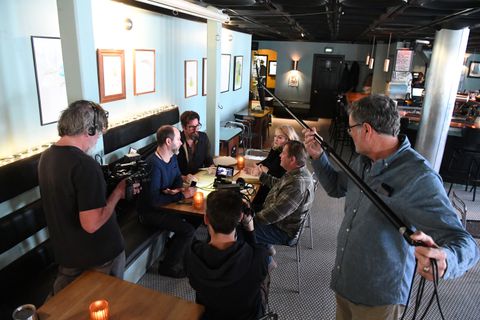 Carey and Danek interview Barley in Baltimore. (Jim Burger/For The Washington Post)
Carey and Danek interview Barley in Baltimore. (Jim Burger/For The Washington Post) There was one relative, though, who spoke of Condit with unabashed glee: Elizabeth Kidd, Barley’s great-aunt Betty, who was Condit’s sister. Barley visited her in Miami in the mid-1970s when he was a kid, and she told him all about Condit’s plans for the trip to Venus. She had been his biggest fan, Barley says, and she was gutted when, in 1971, Condit had died in a roadside motel on his way to visit her in Miami. When his aunt died in 1992, Barley inherited a satchel filled with old papers, which he stashed in a closet. He had forgotten about it until he saw the Facebook page about the guys in Baltimore who were interested in his great-uncle’s rocket.
The filmmakers spent months sifting through the satchel that Barley loaned them. Inside were envelopes dating from 1928, newspaper clippings of Condit and the rocket; there were typed notes and hand-drawn sketches of Venus. I visited the restaurant one afternoon in the fall as they tried to make sense of what was inside. Papers spilled out across the bar. Notes were scrawled on several whiteboards. Covering one wall, Post-its created a timeline of Condit’s life.
They learned that Condit had paid a shipping line to transport what they believed was the rocket to Miami Beach in late 1927. They found rent payments to a landlord for a spot on the boardwalk there and an address for Condit’s house in the South Beach neighborhood. There was a contract, signed by Condit in early 1928, for an exclusive publicity deal with the burgeoning MGM Studios, which wanted to film his launch from the beach. They also found letters from scientists and space enthusiasts, from children and adults, men and women alike, and from as far away as Czechoslovakia, all wanting to know more about his pending trip. Some had experienced the horrors of the First World War, and the idea of escaping to Venus sounded pretty great.
“They had lost a leg or had been injured and they were like: I’m willing to donate my life to go along and accompany you on this mission because I’m no longer any good to society in this way, but I could serve the furtherment of humanity and science by doing this,” Carey told me. “There were a lot of those types of letters.” (Goddard got letters like this, too, after he wrote about a rocket to the moon.) The letters contained the same basic message: Please take me with you.
The letter that really got them, though, was from a kid named Clyde Hafer, a 17-year-old orphan from Newport, Ky., whose parents died when he was young. “I am interested in science and astronomy and would like very much to accompany you,” Hafer wrote in January 1928. “I fully realize the dangers of such an undertaking, but if something would go wrong and we would not get back there is no one that would miss me.”
Something else stood out in the materials. A beautiful art deco book with a German title. It was Hermann Oberth’s 1923 treatise on liquid-propellant fuels. Condit had owned it, in the original German. But perhaps the most enlightening item was a six-page typed lecture prepared by Condit in the winter of 1928 describing not only his reasons for picking Venus — it was, among other factors, closer than Mars — but also his firm belief that a civilized society must exist there. He had read Percival Lowell and knew about the canal theory. Condit claimed he had seen images of the surface of Venus through a telescope where “there are long straight lines longer than the canals of Mars, which can be nothing else [than] avenues of transportation.” He also saw what he believed to be artificial light shimmering from its surface. This must mean, he wrote, that there is an intelligent and centralized government there. He speculated on what the inhabitants of Venus might look like: multiple limbs, probably naked. He had no idea that Venus is, in fact, a broiling hellscape with an atmosphere that would choke any living thing.
Condit did get a few matters right, though. He understood the need for a liquid fuel. He understood the Coriolis effect — that launching from Miami Beach, closer to the equator than Baltimore, would take advantage of Earth’s spin to help get him into space. This was 35 years before NASA established its launch operations at Cape Canaveral, Fla.
This past January, armed with the information in the satchel, the film crew went to Miami Beach hot on the trail of Condit’s rocket. Danek and Carey have pursued this now for 17 years; they want to behold the rocket and discern from it something of its creator.
In late February, a few weeks after they returned from a week-long search in South Florida, I met Benam, Carey and Danek at the house on Morling Avenue. They came home empty-handed and were understandably disappointed not to have found the rocket. But they picked up clues suggesting Condit and his machine may have been heading north, to New York, lured by a savvy publicist who was booking him for a speaking tour. There’s a shipping receipt and a telegram that make them wonder if Condit sent the rocket to a warehouse in the Bronx in 1929. The film crew will search there next, and afterward, they plan to trace Condit to California, where they believe he went in the 1930s.
Maybe, Carey speculated to me, Condit left Miami Beach because he could no longer pretend he’d be flying to Venus. Or maybe he needed more money for the rocket and was looking to cash in on that lecture circuit. Perhaps he still planned on going to space. But then life in the United States imploded. The stock market crashed, men fell from windows onto Wall Street, and the world-altering reality of the Great Depression ended it all. Condit disappeared at the same time as the American economy. The filmmakers know something about unforeseen disasters causing plans to go awry. They had hoped to have the documentary in the can by this fall. But the coronavirus pandemic came, delaying the schedule.
“Do you still think you’ll find it?” I asked. It was an unseasonably warm and sunny winter afternoon, and we were standing in front of the garage where it all began.
In response, Danek told me a story. On the way to Miami Beach, they stopped at Cape Canaveral to talk to a retired astronaut named Winston Scott, a man who has spent more than 24 days in space. “We wanted to ask him what Condit might have been thinking. We wanted to know what it was like going up into space, what goes through your head. He told us that you don’t go up thinking that you won’t get back,” Danek says. “We wouldn’t be on this mission without believing we could find the rocket.” And then he paused. “I have to believe we’ll find it.”
For a moment I imagined the three filmmakers replaced by Condit and the Uhler brothers. I could see the original trio circling the rocket on a sunny day in 1927, readying it for their test flight. How futile their endeavor, but how hopeful, too. That persistent, essential dream of better understanding life beyond our planet.
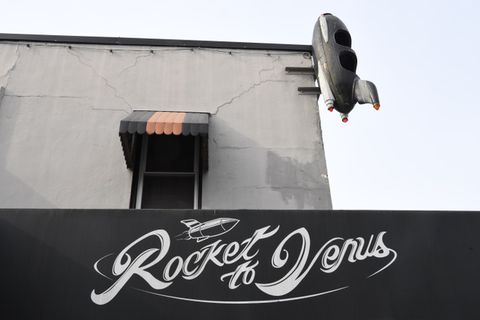 A rocket from a vintage amusement park ride outside Rocket to Venus, Danek and Carey’s restaurant in Baltimore. (Jim Burger/For The Washington Post)
A rocket from a vintage amusement park ride outside Rocket to Venus, Danek and Carey’s restaurant in Baltimore. (Jim Burger/For The Washington Post) Elizabeth Evitts Dickinson is a writer in Baltimore. She last wrote for the Magazine about her mother and the polio epidemic.
Photo editing by Daniele Seiss. Design by Michael Johnson.






